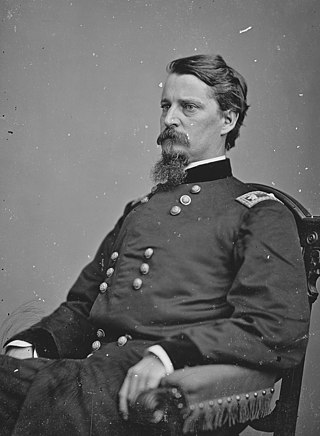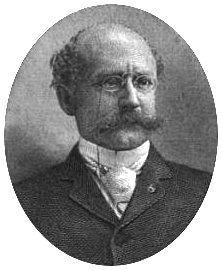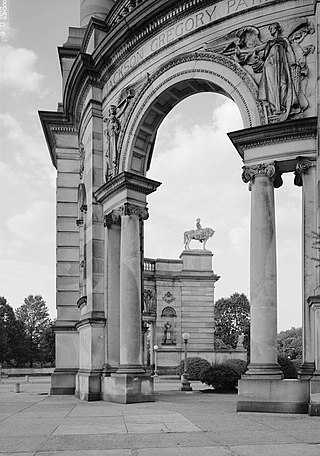
Winfield Scott Hancock was a United States Army officer and the Democratic nominee for President of the United States in 1880. He served with distinction in the Army for four decades, including service in the Mexican–American War and as a Union general in the American Civil War. Known to his Army colleagues as "Hancock the Superb," he was noted in particular for his personal leadership at the Battle of Gettysburg in 1863. His military service continued after the Civil War, as Hancock participated in the military Reconstruction of the South and the U.S.' ethnic cleansing of Native Americans at the Western frontier. This concluded with the Medicine Lodge Treaty. From 1881 to 1885 he was president of the Aztec Club of 1847 for veteran officers of the Mexican-American War.

John Fulton Reynolds was a career United States Army officer and a general in the American Civil War. One of the Union Army's most respected senior commanders, he played a key role in committing the Army of the Potomac to the Battle of Gettysburg and was killed at the start of the battle.

The Union order of battle during the Battle of Gettysburg includes the American Civil War officers and men of the Army of the Potomac. Order of battle compiled from the army organization during the battle, the casualty returns and the reports.

Cyrus Edwin Dallin was an American sculptor best known for his depictions of Native Americans. He created more than 260 works, including the Equestrian Statue of Paul Revere in Boston; the Angel Moroni atop Salt Lake Temple in Salt Lake City; and Appeal to the Great Spirit (1908), at the Museum of Fine Arts, Boston. He was also an accomplished painter and an Olympic archer.

James Edward Kelly was an American sculptor and illustrator who specialized in depicting people and events of American wars, particularly the American Civil War.

Henry Harrison Bingham was an American politician from Pennsylvania who served as a Republican member of the U.S. House of Representatives for Pennsylvania's 1st congressional district from 1879 to 1912. He was a Union Army officer in the American Civil War, fought in some of the key battles of the war and received the United States Military's highest award for valor, the Medal of Honor, for his actions at the Battle of the Wilderness.

During the American Civil War, the Commonwealth of Pennsylvania played a critical role in the Union, providing a substantial supply of military personnel, equipment, and leadership to the Federal government. The state raised over 360,000 soldiers for the Federal armies. It served as a significant source of artillery guns, small arms, ammunition, armor for the new revolutionary style of ironclad types of gunboats for the rapidly expanding United States Navy, and food supplies. The Phoenixville Iron Company by itself produced well over 1,000 cannons, and the Frankford Arsenal was a major supply depot.

William Hays was a career officer in the United States Army, serving as a Union Army general during the American Civil War.
The Battle of Gettysburg, also known as the Gettysburg Cyclorama, is a cyclorama painting by the French artist Paul Philippoteaux depicting Pickett's Charge, the climactic Confederate attack on the Union forces during the Battle of Gettysburg on July 3, 1863.

Smith Memorial Arch is an American Civil War monument at South Concourse and Lansdowne Drive in Philadelphia, Pennsylvania. Built on the former grounds of the 1876 Centennial Exposition, it serves as a gateway to West Fairmount Park. The Memorial consists of two colossal columns supported by curving, neo-Baroque arches, and adorned with 13 individual portrait sculptures ; two eagles standing on globes; and architectural reliefs of eight allegorical figures.

The Pennsylvania State Memorial is a monument in Gettysburg National Military Park that commemorates the 34,530 Pennsylvania soldiers who fought in the July 1 to 3, 1863 Battle of Gettysburg during the American Civil War. The memorial stands along Cemetery Ridge, the Union battle line on July 2, 1863. Completed in 1914, it is the largest of the state monuments on the Gettysburg Battlefield.

Jakob Otto Schweizer was a Swiss-American sculptor noted for his work on war memorials.

The Civil War Monuments in Washington, D.C. are a group of seventeen outdoor statues which are spread out through much of central and northwest Washington, D.C. The statues depict 11 Union generals and formerly included one Confederate general, Albert Pike, who was depicted as a Mason and not as a general. The Pike statue was torn down on Juneteenth 2020, as part of the George Floyd protests. Two Union admirals are honored, although Admiral Samuel Francis DuPont's statue was removed to Wilmington, Delaware, and he is now honored with a fountain. Other statues depict nuns, peace, emancipation, and the Grand Army of the Republic.

General Winfield Scott Hancock is an equestrian statue of Winfield Scott Hancock, by Henry Jackson Ellicott together with architect Paul J. Pelz. It is located at Pennsylvania Avenue in United States Navy Memorial Park at the northwest corner of 7th Street, Northwest, Washington, D.C.

Henry Jackson Ellicott was an American sculptor and architectural sculptor, best known for his work on American Civil War monuments.

Soldiers and Sailors Monument (1908–1911) is a Beaux-Arts monument in Syracuse, New York, dedicated to the 12,265 men of Onondaga County who served in the Civil War. It was designed by architect Clarence Blackall and includes two bronze sculptures, The Call to Arms and An Incident at Gettysburg by Cyrus Dallin. The memorial was erected in Clinton Square, alongside the Erie Canal.

The Menotomy Hunter (1911) is a sculpture by Cyrus E. Dallin in Arlington, Massachusetts, showing a Native American hunter pausing at a brook for a drink of water. It is located between the Arlington Town Hall and the Robbins Memorial Library. The sculpture resides at the center of the garden between Town Hall and the Robbins Library, on a crest above a long, shallow reflecting pool. The man is equipped for a hunt, holding a bow. His catch for the day, a goose, rests by his foot.

The Picket (1905) is an equestrian sculpture by Cyrus E. Dallin in Hanover, Pennsylvania. The work is also referred to by the titles Cavalryman and The Sentry. The sculpture is made of cast bronze and sits on a granite pedestal measuring twelve feet by eight feet. The total height of both the sculpture and the pedestal is twenty feet.

















